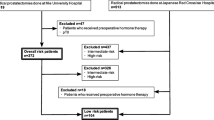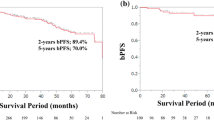Abstract
Background
The aim of this study was to evaluate the oncological outcomes in patients who underwent radical prostatectomy in various risk groups.
Methods
The subjects were 468 patients with clinically localized or locally advanced adenocarcinoma of the prostate (T1-3N0M0) who underwent retropubic radical prostatectomy with/without neoadjuvant and/or adjuvant therapy at Nara Medical University and its affiliated hospitals between January 1997 and December 2006. All patients were stratified by D’Amico risk classification. The independent predictor of biochemical recurrence was determined in each risk group.
Results
Of all 468 patients, 171 patients showed biochemical recurrence during a mean follow-up period of 53 months. The 5-year estimated biochemical recurrence-free survival rates in the low, intermediate, and high-risk groups were 77.3, 71.3, and 46.3%, respectively. The multivariate analysis using Cox’s proportional hazard model showed that patient age in the low-risk group, seminal vesicle involvement in the intermediate-risk group, and prostate-specific antigen value at diagnosis, surgical Gleason score, percent positive core, and perineural invasion in the high-risk group were independent predictors of biochemical recurrence.
Conclusions
The high-risk patients showed a significant higher biochemical recurrence than the low- and intermediate-risk patients. The independent predictor of biochemical recurrence was different in each risk group.

Similar content being viewed by others
References
Cooperberg MR, Broering JM, Kantoff PW et al (2007) Contemporary trends in low risk prostate cancer: risk assessment and treatment. J Urol 178:S14–S19
Hernandez DJ, Nielsen ME, Han M et al (2007) Contemporary evaluation of the D’Amico risk classification of prostate cancer. Urology 70:931–935
Tanaka N, Fujimoto K, Hirayama A et al (2010) Trends of the primary therapy for patients with prostate cancer in Nara Uro-oncological Research Group (NUORG): a comparison between the CaPSURE data and the NUORG data. Jpn J Clin Oncol 40:588–592
D’Amico AV, Whittington R, Malkowicz SB et al (1998) Biochemical outcome after radical prostatectomy, external beam radiation therapy, or interstitial radiation therapy for clinically localized prostate cancer. JAMA 280:969–974
Hull GW, Rabbani F, Abbas F et al (2002) Cancer control with radical prostatectomy alone in 1,000 consecutive patients. J Urol 167:528–534
Taira AV, Merrick GS, Galbreath RW et al (2010) Natural history of clinically staged low- and intermediate-risk prostate cancer treated with monotherapeutic permanent interstitial brachytherapy. Int J Radiat Oncol Biol Phys 76:349–354
Kuban DA, Tucker SL, Dong L et al (2008) Long-term results of the M. D. Anderson randomized dose-escalation trial for prostate cancer. Int J Radiat Oncol Biol Phys 70:67–74
Kattan MW, Eastham JA, Stapleton AM et al (1998) A preoperative nomogram for disease recurrence following radical prostatectomy for prostate cancer. J Natl Cancer Inst 90:766–771
Han M, Partin AW, Zahurak M et al (2003) Biochemical (prostate specific antigen) recurrence probability following radical prostatectomy for clinically localized prostate cancer. J Urol 169:517–523
Makarov DV, Trock BJ, Humphreys EB et al (2007) Updated nomogram to predict pathologic stage of prostate cancer given prostate-specific antigen level, clinical stage, and biopsy Gleason score (Partin tables) based on cases from 2000 to 2005. Urology 69:1095–1101
Naito S, Kuroiwa K, Kinukawa N et al (2008) Validation of Partin tables and development of a preoperative nomogram for Japanese patients with clinically localized prostate cancer using 2005 International Society of Urological Pathology consensus on Gleason grading: data from the Clinicopathological Research Group for Localized Prostate Cancer. J Urol 180:904–910
Egawa S, Suyama K, Arai Y et al (2001) Treatment outcome by risk group after radical prostatectomy in Japanese men. Int J Urol 8:295–300
D’Amico AV, Whittington R, Malkowicz SB et al (2000) Clinical utility of the percentage of positive prostate biopsies in defining biochemical outcome after radical prostatectomy for patients with clinically localized prostate cancer. J Clin Oncol 18:1164–1172
Freedland SJ, Aronson WJ, Terris MK et al (2003) Percent of prostate needle biopsy cores with cancer is significant independent predictor of prostate specific antigen recurrence following radical prostatectomy: results from SEARCH database. J Urol 169:2136–2141
Briganti A, Chun FK, Hutterer GC et al (2007) Systematic assessment of the ability of the number and percentage of positive biopsy cores to predict pathologic stage and biochemical recurrence after radical prostatectomy. Eur Urol 52:733–743
Manoharan M, Bird VG, Kim SS et al (2003) Outcome after radical prostatectomy with a pretreatment prostate biopsy Gleason score of >/=8. BJU Int 92:539–544
Swindle P, Eastham JA, Ohori M et al (2005) Do margins matter? The prognostic significance of positive surgical margins in radical prostatectomy specimens. J Urol 174:903–907
Harnden P, Shelley MD, Clements H et al (2007) The prognostic significance of perineural invasion in prostatic cancer biopsies: a systematic review. Cancer 109:13–24
Suekane S, Noguchi M, Nakashima O et al (2007) Percentages of positive cores, cancer length and Gleason grade 4/5 cancer in systematic sextant biopsy are all predictive of adverse pathology and biochemical failure after radical prostatectomy. Int J Urol 14:713–718
Boorjian SA, Karnes RJ, Rangel LJ et al (2008) Mayo Clinic validation of the D’Amico risk group classification for predicting survival following radical prostatectomy. J Urol 179:1354–1361
Conflict of interest
No author has any conflict of interest.
Author information
Authors and Affiliations
Corresponding author
Additional information
An erratum to this article can be found online at http://dx.doi.org/10.1007/s10147-013-0527-8.
About this article
Cite this article
Tanaka, N., Fujimoto, K., Hirayama, A. et al. Risk-stratified survival rates and predictors of biochemical recurrence after radical prostatectomy in a Nara, Japan, cohort study. Int J Clin Oncol 16, 553–559 (2011). https://doi.org/10.1007/s10147-011-0226-2
Received:
Accepted:
Published:
Issue Date:
DOI: https://doi.org/10.1007/s10147-011-0226-2




